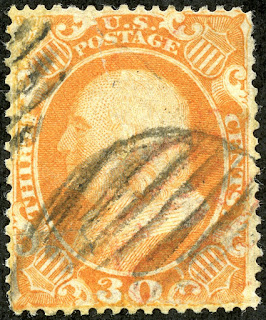Into the Deep Blue
When I went to PIPEX (Portland, OR) in May, I picked up some nice USA and Canada, as well as Australia. Since I don't specialize in any one country as a classical WW collector, I don't have a "wow" collection of either the USA or Canada. But that doesn't mean I can't have nice things. 😎
In particular, I did pick up four USA classical era stamps, which will be shown shortly. And I will also take a look at my copy of Lester Brookman's "The 19th Century Postage Stamps of the United States" two volume book (1947) to see what he said about them.
An anecdote...
When I was much younger than I am now, Lester Brookman had a retail stamp store in Minneapolis. I remember taking a bus to Minneapolis for a day excursion to his store. There he was at his desk, doing important stamp things. He was philatelically quite famous, and I knew enough to be awe-struck, even if he was not particularly aware I was there. As a teenager, and only buying "average" rather than "VF" stamps from his Brookman USA Stamp catalogue, I was waited on by his spouse for my stamp needs.
Type III is defined as "The outer lines are broken above the top label and the "X" numerals. The outer line at the bottom and the shells are partly cut away, similar to Type II". (Note that Type II has the design complete at the top.)
This stamp looks like Type II to me, but was sold as a Type III. (The CV is the same @ $140.)
One of the criticisms of the Scott catalogue for the USA is they break down minor differences, that are sometimes difficult to see, into major numbers with "types" commanding high CVs (And, hence, the need for a completest USA collector to acquire them). Here, for instance, a "Type I" or "Type IV" are $800 & $1600 CV respectively. Actually, I don't have a problem with the "types": They are real, but require close attention. But perhaps a larger argument could be made that the "types" should be minor numbers.
The Brookman says, for Type II, "This type is the most common of the types for the ten cent imperforate since it occurs on 93 out of every 200 stamps". There were some 2,300,000 Type IIs issued.
Can't tell the city, but a nice blue cancel with a clear date on this 24c stamp. The major color is "gray lilac", while the minor color is "gray" - this has a "gray" color. CV for both are the same (CV $375).
Brookman says that 750,000 stamps were released.
The 30c orange in the same 1860 issue is CV $425.
I notice my copy has a white line running from 11:30 from the top of the oval through the head angling slightly right. Is this the infamous "cracked plate" (plate scratch) variety noted by Brookman, or merely a printing stamp fault?
Brookman says that 357.000 stamps were produced, some of which were returned to the department and destroyed.
I note that even well desired classical USA has been a little CV "soft", as comparing CV prices from 2011 to now, the 30c orange, the 24c gray, and the 10c green (all illustrated above) have dropped ~ $25.
Between 1867-1870, some stamp issues of 1861-66 were embossed with grills of different sizes.
The purpose was to make it more difficult to remove a cancel and reuse the stamp for postage.
Scott gives each grill size stamp their own major number. CVs can run between $10 and $3,000,000 (The famous "Z" grill on the 1c blue).
The "E" grill 10c green has a CV of $325, while the similar no grill example 10c green of 1861 is $55.
There are five grill examples with a CV of six figures, and two grill examples of seven figures (The 1c blue "Z" grill, the highest CV of any U.S. stamp, is one of them). !!!!!
This is the last stamp produced for the "Canada colony" (Province of Canada), as it became part of the Dominion of Canada in 1867. Colors are "rose" (CV $300) and "deep claret rose".
The "small queens" issue (1870-89) was Perf 12, but there were eight denominations produced between 1873-79 that had Perf 11 1/2 X 12 (occasionally 11 3/4 X 12), and are given minor numbers in Scott. They have a higher CV, so it is important to carefully measure perforations. Here, the CV is $65, while the Perf 12 is CV $27+.
Out of the Blue
Hope you enjoyed the additions to "Deep Blue". !!
Comments appreciated!








Hey Jim, I'm pretty sure that your U.S. 37 has a Baltimore cancel. Hope this helps!
ReplyDeleteThanks Ray!
ReplyDelete